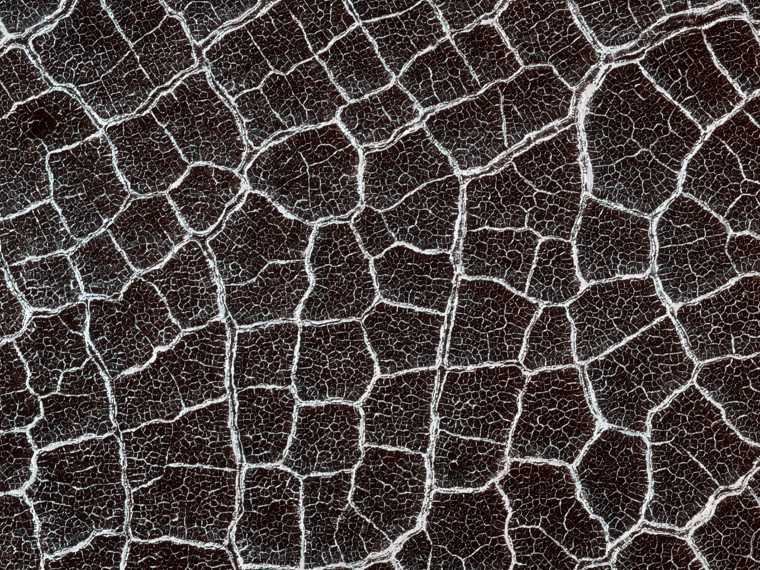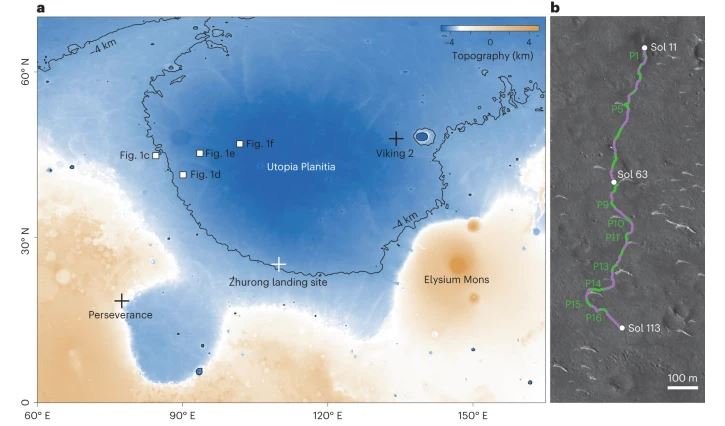
Posted on 02/06/2024 9:45:55 AM PST by Red Badger

Mysterious polygons spotted by NASA in 2012. Image Credit: NASA/JPL-Caltech/University of Arizona
~~~~~~~~~~~~~~~~~~~~~~~~~~~~~~~~~~~~~~~~~~~~~~~~~~~~~~~~~~~~~~
Researchers operating China’s Zhurong rover say they have spotted a series of mysterious polygons hidden beneath the planet’s surface, similar to polygons NASA spotted on the surface of Mars in 2012. The newly discovered features, however, were detected more than 35 kilometers beneath the planet’s surface.
While researchers believe that these polygon structures could have formed due to extreme environmental shifts in Mars’ ancient past, their exact nature and formation remain a mystery.
The discovery was initially made during the rover’s one-year mission, which lasted from May 2021 to May 2022, in the Utopia Planitia region. Described by researchers from the Institute of Geology and Geophysics under the Chinese Academy of Sciences as the largest impact crater in the entire solar system, the researchers behind this mysterious find say that Utopia Planitia “has both experienced and recorded variations of the Martian palaeoclimate.”
By using the rover’s ground penetrating radar, researchers scoured a 1.2-kilometer-wide area for various geological features. As a result, 16 mysterious polygons were spotted below a depth of 35 meters, meaning they were likely formed billions of years in the planet’s past.

Zhurong rover landing site and images of polygonal terrain in Utopia Planitia. Image Credit NASA/Zhang et al.
Perhaps even more significant, the researchers say that the 16 polygons spotted by Zhurong could be evidence of a long, wet period on ancient Mars, which would dramatically increase the chances that life once existed on the red planet.
“[The] formation mechanism for the buried palaeo-polygonal terrain requires a cold environment and might be related to water/ice freeze–thaw processes in southern Utopia Planitia on early Mars,” the researchers explain in the journal Nature Astronomy. “The detected buried polygons, which indicate that freezing occurred at low-to-mid latitudes, require strong palaeoclimatic variability.”
NASA, who spotted similar features on Mars’ surface back in 2012, says they study the mysterious polygons “because the occurrence and physical characteristics of the polygons helps us understand the recent and past distribution of ice in the shallow subsurface [and] also provide clues about climate conditions.”
Of course, this is not the first time rovers have spotted something unusual on the red planet. For instance, a mysterious string was photographed by NASA’s Perseverance rover back in July 2022 before a photo taken four days later showed it had suddenly disappeared.
Rover operators have also spotted an unusual “flower” on Mars, a feature described as a “door,” and a number of pieces of debris left behind my previous missions. Just last October, rover operators even recorded a Martian whirlwind racing across the planet’s surface.
As for the recently discovered mysterious polygons hidden beneath the Martian surface, the researchers say they were potentially formed sometime between 3.7 and 2.9 billion years ago. While the exact process is unknown, the researchers say that their creation almost certainly involved large amounts of water, perhaps from water trapped underground that was pulled to the surface or even from ancient snowfall on the red planet.
“The possible presence of water and ice required for the freeze–thaw process in the wedges may have come from cryogenic suction-induced moisture migration from an underground aquifer on Mars, snowfall from the air, or vapor diffusion for pore ice deposition,” they explain.
While the Zhruong rover was decommissioned in 2022, the researcher note that the planet’s Utopia Planitia region is still one of the best places on the planet to search for signs of ancient water activity.
“The Zhurong landing site is thought to be one of the best places for detecting ground ice at low-to-mid latitudes on Mars25,” they write. “The GPR onboard Zhurong rover, thus, provides an unprecedented opportunity to illuminate subsurface structures and to investigate geological processes, particularly those associated with ancient or current water-related activities in southern Utopia Planitia.”
~~~~~~~~~~~~~~~~~~~~~~~~~~~~~~~~~~~~~~~~~~~~~~~~~~~~~~~~~~~
Christopher Plain is a Science Fiction and Fantasy novelist and Head Science Writer at The Debrief. Follow and connect with him on X, learn about his books at plainfiction.com, or email him directly at christopher@thedebrief.org
Did he win?
Sure he won! He was the only one in the race!
Democrat, of course..............
That was put down by the Martians when they poured concrete a concrete slab.
Yes, just a fairly common occurrence with soil when the water is evaporated
“Underground tunnels?”
That is where I was going with these images... :)
Wormsign.......................
Lol, Dune connection there...
Ancient rice paddies destroyed my global warming.
Ancient rice paddies destroyed my global warming.
Lol! I observed your actions, hitherto!
At 150 feet down I imagine these polygons are fairly large - on the order of tens of feet across to be able to be imaged by GPR.
It could be dessication or freeze/thaw, but they are below an impact crater. I wonder if they could have been caused by the impact? A layer of stiff buried material at the time of the impact, and ending up looking like shattered glass?
I get a kick how EVERYTHING now-a-days gets referenced to climate change.
Your gas guzzling SUV caused these peculiar patterns on Mars... somehow.
I might add that the ambiguity of the scale of the image is an excellent reminder of the fractal nature of the physical universe. Is it a planet, is it a fleck of Michael Moore’s dandruff?
LOL..me too!
What’s the big deal?
It’s in an area where ice forms, and when the soil dries out you get what we’re seeing in this photo. Cracked earth forming polygons.
Mud in their eyes. These Space research guys never saw mud before. What a bunch of morons.
Exactly. That was my first thought. It probably does confirm that water was once there.
😅🤣😂
That would be my conclusion
After all, Ice 🧊🧊🧊 🥶 🥶 🥶 caps on Mars; at least Northern
Disclaimer: Opinions posted on Free Republic are those of the individual posters and do not necessarily represent the opinion of Free Republic or its management. All materials posted herein are protected by copyright law and the exemption for fair use of copyrighted works.